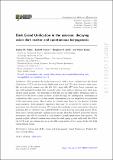Dark Grand Unification in the axiverse: decaying axion dark matter and spontaneous baryogenesis
Author(s)
Foster, Joshua W.; Kumar, Soubhik; Safdi, Benjamin R.; Soreq, Yotam
Download13130_2022_Article_19856.pdf (1.862Mb)
Publisher with Creative Commons License
Publisher with Creative Commons License
Creative Commons Attribution
Terms of use
Metadata
Show full item recordAbstract
Abstract
The quantum chromodynamics axion with a decay constant near the Grand Unification (GUT) scale has an ultralight mass near a neV. We show, however, that axion-like particles with masses near the keV–PeV range with GUT-scale decay constants are also well motivated in that they naturally arise from axiverse theories with dark c gauge groups. We demonstrate that the correct dark matter abundance may be achieved by the heavy axions in these models through the misalignment mechanism in combination with a period of early matter domination from the long-lived dark glueballs of the same gauge group. Heavy axion dark matter may decay to two photons, yielding mono-energetic electromagnetic signatures that may be detectable by current or next-generation space-based telescopes. We project the sensitivity of next-generation telescopes including Athena, AMEGO, and e-ASTROGAM to such decaying axion dark matter. If the dark sector contains multiple confining gauge groups, then the observed primordial baryon asymmetry may also be achieved in this scenario through spontaneous baryogenesis. We present explicit orbifold constructions where the dark gauge groups unify with the SM at the GUT scale and axions emerge as the fifth components of dark gauge fields with bulk Chern-Simons terms.
Date issued
2022-12-20Department
Massachusetts Institute of Technology. Center for Theoretical PhysicsPublisher
Springer Berlin Heidelberg
Citation
Journal of High Energy Physics. 2022 Dec 20;2022(12):119
Version: Final published version